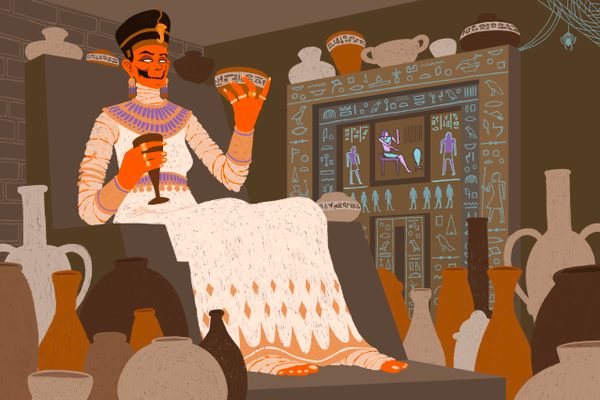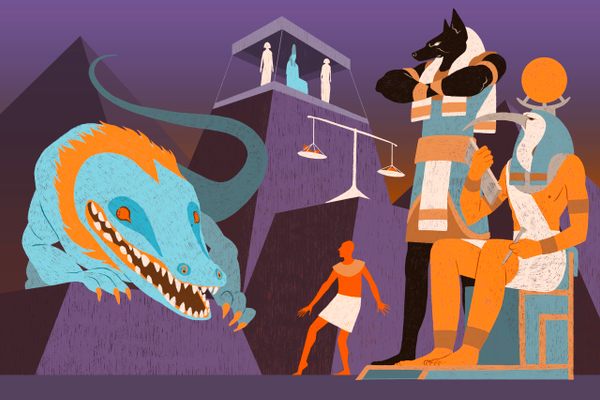In Ancient Egypt, Human Sacrifice and Shabti Figures Ensured an Afterlife of Servitude
Clay figurines and murdered retainers provided plenty of company—and a workforce—for the dead.
Each week in October, University of Manchester Egyptologist Nicky Nielsen will share an intriguing aspect of ancient Egyptian beliefs and traditions surrounding death and the afterlife.
Today, the heart of Cairo is Tahrir Square. It is a bustling, vibrant space in one of the busiest cities on the planet. But there is tranquillity too. In the center of the square stands the Egyptian Museum, an early-20th-century neoclassical building filled with hundreds of thousands of artifacts recounting the history and culture of Pharaonic Egypt. Entering the echoing, cavernous halls of the museum, visitors are confronted with a stunning siltstone slab measuring nearly three feet in height: the Narmer Palette.
Ancient Egyptian palettes were carved with details of important historical or religious events, and the Narmer is both the largest and best preserved example. It was a ritual object, intended to be displayed in a temple, and shows King Narmer, the first ruler of a unified Egypt, who ascended the throne nearly 5,200 years ago. He raises a heavy, stone-tipped mace in his right hand. With his left, he holds down a prisoner of war. The depiction captures the moment before Narmer brings the mace down on his defeated enemy, possibly as a sacrifice to the gods.
This image of the Egyptian pharaoh, right hand raising a weapon, left hand holding down a captive, is found throughout Egyptian temples. For more than 3,000 years, the kings of Egypt chose to portray themselves in this moment of supreme power over life and death.
And there is certainly evidence that this practice was not merely symbolic. The body of a decapitated enemy was found outside the Egyptian fortress of Mirgissa in Nubia along with melted wax figures and other magical items. A cache of severed hands, most likely cut from defeated officers and nobles, was recently found in the settlement of Avaris (modern Tell el-Dab’a). But killing captive enemies was not the only form of human sacrifice practiced during the early dynasties of the Pharaonic Period.

There is archaeological evidence to suggest the practice of retainer sacrifice during the First Dynasty, which lasted from roughly 3100 to 2900 BC. Unlike the dispatch of defeated enemies, retainer sacrifice targeted those members of the court whom the deceased ruler needed most in the afterlife.
The evidence for retainer sacrifice is in some ways problematic as it is based almost exclusively on extrapolation rather than hard data. The tomb of king Hor-Aha is a good example: The tomb has not survived in good shape, having been subjected to repeated lootings. But a number of burial pits around the royal burial exclusively contain the bones of young men and women, an unusual demographic to have died from natural causes, even in ancient Egypt.
None of the remains of sacrificed retainers during the First Dynasty show any obvious signs of violence, in contrast to the bodies of executed enemies. There are no beheadings, no crushed skulls. Instead, the bodies were interred with respect, laid out in an orderly fashion, perhaps emulating the hierarchy of the living court. Some evidence suggests that the victims were strangled, but poisoning is also an option.
While the sacrifice of captured enemies most likely continued throughout the Pharaonic Period (and was by no means exclusive to ancient Egypt), the fashion of retainer sacrifice died out relatively quickly. The second ruler of the First Dynasty, King Djer, was buried with more than 300 sacrificed retainers, whereas King Qa’a—less than 200 years later, the last ruler of the First Dynasty—was buried with only 26.

In their place, the Egyptian elite developed other means of ensuring that their needs were met in the afterlife. Servant statues, carved from stone, showing men and women grinding grain, brewing beer, and baking bread, and were popular during the Old Kingdom (2700–2200 BC). Wooden models of granaries, cattle yards, and even fully functioning river boats became fashionable during the Middle Kingdom (2040–1782 BC). These items would all magically be imbued with life in the netherworld and thus fulfil the function of living servants.
By the New Kingdom (1550-1069 BC), both royals and non-royals were being buried with dozens of shabti figurines. These were basic representations of agricultural workers, many of them inscribed with a magical spell which would cause them to spring to life and work in the fields of the afterlife. This ensured that the tomb owner would not have to dirty their own hands while also guaranteeing a never-ending supply of bread and beer, the two things no ancient Egyptian soul would be caught dead without.





























Follow us on Twitter to get the latest on the world's hidden wonders.
Like us on Facebook to get the latest on the world's hidden wonders.
Follow us on Twitter Like us on Facebook